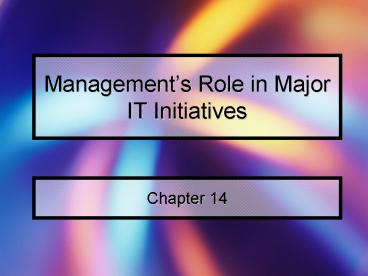Managements Role in Major IT Initiatives - PowerPoint PPT Presentation
1 / 16
Title:
Managements Role in Major IT Initiatives
Description:
Management's Role in Major IT Initiatives. Chapter 14. Outline ... Leadership plays an essential role in managing the change that accompanies IT implementations ... – PowerPoint PPT presentation
Number of Views:209
Avg rating:3.0/5.0
Title: Managements Role in Major IT Initiatives
1
Managements Role in Major IT Initiatives
- Chapter 14
2
Outline
- Managing organizational change
- Managing projects
- Factors that contribute to IT initiative failures
3
Types of Organizational Change Keen, 1997
- Incremental
- Step-shift
- Radical
- Fundamental
4
Effecting Organizational Change Keen, 1997
- Leadership
- Language and vision
- Connection and trust
- Incentives
- Plan, implement and iterate
5
Project Management Objectives
- Define project scope and goals
- Identify accountability
- Define decision-making processes
- Identify tasks and task sequence and
interdependencies - Determine resource and time requirements
- Ensure appropriate communication
6
Project Roles
- Business sponsor
- Secure resources
- Final decision making and accountability
- Identify and support Business Owners
- Promote project and obtain buy-in
- Chair Project Steering Committee
- Define objectives, deliverables, scope and
success criteria - Remove obstacles
7
Project Roles
- Business Owner
- Represent department or function
- Obtain resources
- Remove obstacles
- Work with Project Manager
- Project Manager
- Obtain resources
- Deliver project on time and on budget
- Communicate
- Manage project risk
- Resolve issues and problems
- Maintain plan
- Manage scope
8
Project Committees
- Project Steering Committee
- Provide overall guidance and management
- Resolve project issues and problems
- Project Team
- Manage the project work
- Resolve day-to-day issues
- Manage and allocate resources
9
Project Management
- Project Charter
- Project overview and objectives
- Desired application features
- Scope and limitations
- Success metrics
- Budget and timetable
- Project organization
- Project management strategies
10
Project Management
- Project Plan
- Project phases and tasks
- Sequence of phases and tasks
- Interdependencies
- Duration of tasks and phases
- Staff resources
11
Characteristics of a Good Project Plan and Charter
- Charter is clear and explicit
- Leadership understands and supports the plan
- Timelines and resource needs have been thoroughly
reviewed - Accountabilities are clear
- Project risks have been assessed
- Appropriate contingency has been incorporated
12
Factors That Contribute to IT Initiative Failures
- Lack of clarity of purpose
- They dont believe you
- Leadership support is insufficient
- Organizational inertia
- Organizational baggage
- The reward system is not there
- Lack of candor
13
Factors That Contribute to IT Initiative Failures
- Complexity of the project
- Failure to respect uncertainty
- Undernourished initiatives
- Failure to anticipate short term disruptions
- Invisible progress
- Unstable/immature technology
14
Steps to Minimize Risk of Failure
- Ensure that objectives are clear
- Test commitment
- Demonstrate conviction
- Hammer away at inertia
- Distance project from baggage
- Change the reward system
- Accept debate, invite bad news and do not punish
those who make mistakes
15
Steps to Minimize Risk of Failure
- Reduce complexity
- Accept the imperfection of understanding of the
needed changes - Resource appropriately
- Limit depth and duration of disruption
- Communicate progress
- Avoid new technologies
16
Summary
- Leadership plays an essential role in managing
the change that accompanies IT implementations - Good project management is essential and requires
well developed charters, plans, committees and
roles - Leadership must take steps to reduce project
failure risks































